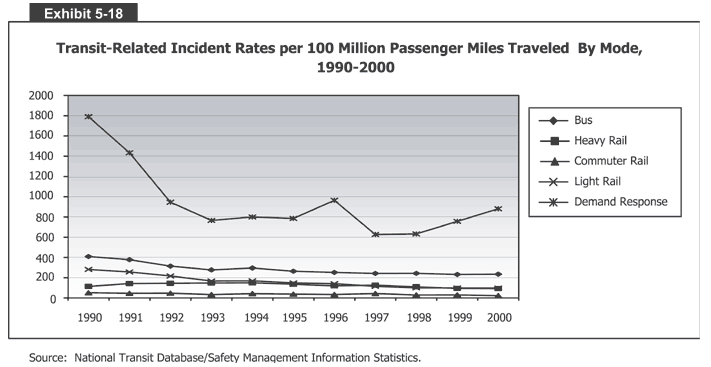U.S. Department of Transportation
Federal Highway Administration
1200 New Jersey Avenue, SE
Washington, DC 20590
202-366-4000
Conditions and Performance
Status
of the Nation's Highways, Bridges, and Transit:
2002 Conditions and Performance Report
|
Exhibit 5-18:
Transit-Related Incident Rates per 100 Million Passenger Miles Traveled By Mode,
1990-2000
 Exhibit 5-18 is a chart that shows transit-related incident rates per 100 million passenger miles traveled (PMT) by mode in from 1990 to 2000. The vertical axis measures incidents from 0 to 2000 in increments of 200. The horizontal axis measures each year from 1990 to 2000. The first of five modes, demand response, had the largest numbers; there were 1800 demand-response incidents in 1990, dropping to 1400 in 1991 and 950 in 1992. The number then settled around 800 from 1993 to 1995, rising to 980 in 1996, and dropping to 620 in 1997 and 1998. It then rose to 650 in 1999 and 850 in 2000. The other four modes had lower and more stable incident numbers. Buses had 400 incidents per 100 million PMT in 1990, dropping steadily to 300 by 1993 and 1994, and leveling off at about 250 each year from 1995 to 2000. Light rail started at about 300 in 1990, dropping to less than 200 by 1993, and declining steadily to about 100 per year by 2000. Heavy rail actually rose from about 100 in 1990 to 150 by 1993, but then steadily declined back to 100 by 2000. And commuter rail had the lowest incident rates per 100 million PMT, hovering at or below 50 per year over the time period.
Exhibit 5-18 is a chart that shows transit-related incident rates per 100 million passenger miles traveled (PMT) by mode in from 1990 to 2000. The vertical axis measures incidents from 0 to 2000 in increments of 200. The horizontal axis measures each year from 1990 to 2000. The first of five modes, demand response, had the largest numbers; there were 1800 demand-response incidents in 1990, dropping to 1400 in 1991 and 950 in 1992. The number then settled around 800 from 1993 to 1995, rising to 980 in 1996, and dropping to 620 in 1997 and 1998. It then rose to 650 in 1999 and 850 in 2000. The other four modes had lower and more stable incident numbers. Buses had 400 incidents per 100 million PMT in 1990, dropping steadily to 300 by 1993 and 1994, and leveling off at about 250 each year from 1995 to 2000. Light rail started at about 300 in 1990, dropping to less than 200 by 1993, and declining steadily to about 100 per year by 2000. Heavy rail actually rose from about 100 in 1990 to 150 by 1993, but then steadily declined back to 100 by 2000. And commuter rail had the lowest incident rates per 100 million PMT, hovering at or below 50 per year over the time period.
Source: National Transit Database/Safety Management Information Statistics.
Back
to Chapter 5
Return to top
Page last modified on November 7, 2014
